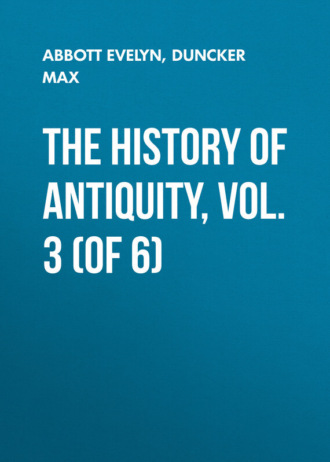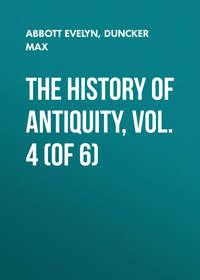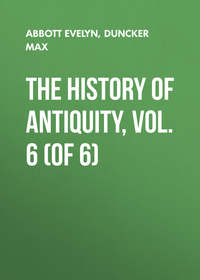 полная версия
полная версияThe History of Antiquity, Vol. 3 (of 6)
Vol. I. p. 301. Abyden. fragm. 8, 9, ed. Müller. The position of the βασίλειος ποταμός is fixed by Ptolemy, 5, 17. That Nebuchadnezzar caused the Nahr Malka to be excavated follows from the words of Abydenus in Eusebius ("Chron." I. p. 37, ed. Schöne): Armacalen fluvium ex Arazane (Euphrate) derivavit: cp. "Præp. Evang." 9, 41. Armacale must obviously be the same name as Nahr Malka. Cp. Plin. "Hist. Nat." 6, 26 (30). On the position of the Nahr Malka, Xen. "Anab." 2-4. Ammian. Marcell. 26, 6; and that it was navigable, Herod. 1, 193.
686
Abydenus in Eusebius, loc. cit. "Præp. Evang." 9, 41. Diod. (2, 9) ascribes this basin, as he does all the buildings of Babylon, with the exception of the hanging gardens, to Semiramis. Herodotus describes the basin, and considers the maker of it to be, not Semiramis, but Nitocris, who lived five generations later. To the same queen he ascribes the works in the bed of the Euphrates, the embankment of the river, and the bridge over the Euphrates, 1, 184-188. He fixes the date of Nitocris more precisely when he states that Cyrus marched against her son, who like his father was called Labynetus, and took Babylon. We know for certain that no woman reigned over Babylon from Nabopolassar to the overthrow of the kingdom. Herodotus' knowledge about the kingdom of Babylon is extremely scanty; he obtained his information, it would seem, chiefly through the Persians; and it is restricted chiefly to these two names, Nitocris and Labynetus, for he denotes by the same name the Babylonian, who arranged the peace between the Medes and the Lydians (supr. p. 260). In the one case Nabopolassar is meant by Labynetus, in the other Nabonetus; and so Nitocris can only be Amyite, the daughter of Cyaxares, the consort of Nebuchadnezzar (p. 285). The statement of Berosus in Abydenus, putting the extent of the basin at 40 parasangs (it is also found in Diodorus, 2, 9, viz. 1200 stades), is so exaggerated that in this particular the statement of Herodotus, who allows an extent of 420 stades to the lake, deserves the preference. Diodorus, loc. cit., gives the depth as stated in the text; according to the Armenian Eusebius it was 20 cubits; according to the "Præp. Evang.," which also quote Abydenus, it was 20 fathoms, i. e. 120 feet.
687
Herod. 1, 185. It is clear from the account of Herodotus that the artificial bends in the river-bed lay above Sippara. The object which Herodotus ascribes to these works in the river – that the long and winding navigation and the large lake were intended to hinder the Medes from coming to Babylon and seeing what took place there – is naïve enough. The Ardericca of Herodotus is, no doubt, identical with the Idikara of Ptolemy, which he places more than three-fourths of a degree higher up the Euphrates than Sippara. Ptolem. 5, 17, 19.
688
Aristobulus in Strabo, p. 766. Eusebius, "Chron." 1, p. 40, ed. Schöne; "Præp. Evang." 9, 41. Dionys. "Perieg." v. 982. Ptolem. 5, 19. Movers' somewhat different view on Gerrha is given, "Phœnizier," 2, 3, 308.
689
Isaiah xliii. 14. Æsch. "Pers." v. 52-55. Arrian, "Ind." 32. Strabo, p. 766.
690
Strabo, loc. cit. Diodorus, 14, 21, 81. Vol. II. p. 297.
691
Movers, "Phœnizier," 2, 3, 306. This road certainly cannot be carried back to the Phenicians; the nearest way, from Nineveh to Syria, often traversed by the Assyrian kings on their campaigns, passed by Karchemish on the lower Orontes.
692
Plin. "Hist. Nat." 6, 26 (30).
693
Eratosthenes in Strabo puts the length of the wall at 200 stades (25 miles) only, Xenophon at 20 parasangs (75 miles), "as it is said: " in his time a part of the wall was still standing, "Anab." 2, 4; cp. Joseph, "c. Apion." 1, 20. But it is at the same time clear from the whole narrative of Xenophon that the Median wall was not situated at the narrowest point, but far higher up, where the distance between the rivers is far wider, i. e. above Sittace. We have no definite evidence that this wall was built by Nebuchadnezzar. If Strabo ascribes it to Semiramis, that means no more than the fact that the modern inhabitants give the name Sidd Nimrud to the remains. A wall against attacks from the North, against attacks of the Medes, would have no meaning before the rise of the power of the Medes; its origin and importance are entirely due to anxiety in regard to the Medes, and that such anxiety did exist, was due to the experience which Babylonia had had of Assyria, and the relative power of the two kingdoms; and it is also shown in the statements of Herodotus about the object of the windings in the river and the lake. The successors of Nebuchadnezzar were hardly in a position to undertake such works. This could be done at most by Nabonetus; but as Josephus ("c. Apion." 1, 20) quotes from Berosus a comparatively unimportant building of this king, the Median wall would not have been forgotten if it had arisen from him. On the direction of the wall, cp. Grote, "Hist. of Greece," 9, 89.
694
Beros. fragm. 14, ed. Müller.
695
Herod. 1, 186.
696
Herod. 1, 178, 179.
697
Herod. 3, 159.
698
Xenoph. "Anab." 2, 2, 6. "Inst. Cyr." 7, 5, 7, 21.
699
Diod. 2, 7. Cp. Arrian, "Anab." 7, 17, 6. Pseudo-Callisthenes ascribes to Babylon a diameter of no more than 12 stades and 220 or 206 feet: he ascribes to the city of Alexandria in Egypt a diameter of 16½ stades; 1, 31.
700
Diod. 2, 7.
701
Eumenes in Æl. "Var. Hist." 3, 23.
702
So the Ephemerides in Arrian, "Anab." 7, 25, and in Plut. "Alex." c. 75.
703
"Pol." 3, 1, 12.
704
Jerem. li. 53, 58.
705
"Hist. Nat." 6, 26.
706
Vol. I. p. 295.
707
Joseph. "c. Apion." 1, 19.
708
Oppert, "Exped." 1, 140 ff.
709
Joseph. "c. Apion." 1, 19.
710
Euseb. "Præp. Evang." 9, 41, 8.
711
Diod. 2, 10.
712
Strabo, p. 738.
713
Oppert, "Exped." 1, 156 ff.
714
It is the less doubtful that the bridge is the work of Nebuchadnezzar, since the basin of Sepharvaim is vouched for as his work by Berosus.
715
Diod. 2, 8.
716
Herod. 1, 186.
717
"Inst. Cyri," 7, 6.
718
Ménant, "Babylone," p. 213.
719
W. A. Inscript. 1, 52. No. 6 in Ménant, "Babylone," p. 215.
720
Ménant, loc. cit., p. 214
721
Ménant, loc. cit., p. 213.
722
Ménant, loc. cit., p. 208.
723
Colum. 6, 22; 8, 42.
724
Ménant, "Babylone," p. 200 ff. Rodwell, "Records of the Past," 5, 113 ff. Two private documents of the reign of Nebuchadnezzar are in existence, one from the first part of his reign, 604 B.C.; the second from the twentieth, 584 B.C. Oppert et Ménant, "Doc. Juridiq." p. 257 ff.
725
Ménant, loc. cit., p. 215.
726
Joseph. "c. Apion." 1, 19.
727
Isaiah xiii. 19 ff.
728
Arrian, "Anab." 7, 19, 4.
729
Ménant, loc. cit., p. 218.
730
Berosi fragm. 14, ed. Müller.
731
2 Kings xxv. 27-30.
732
Oppert, "Exped." 2, 324, cf. 1, 181.
733
Ménant, loc. cit., p. 249.
734
Berosi fragm. 14, ed. Müller. That Evilmerodach ascended the throne in 561 B.C. is established, not only by the astronomical canon, but also by the statement of the Hebrews that Evilmerodach liberated Jechoniah in the thirty-seventh year of his imprisonment, 2 Kings xxv. 27. Jerem. lii. 31. Between Nebuchadnezzar and Nabonetus the astronomical canon only mentions Evilmerodach and Neriglissar, with six years between them. Josephus supplements this by the dates of the years in Berosus ("c. Apion." 1, 20), which in the result agree with the canon. Cf. Euseb. "Chron." 1, p. 50, ed. Schöne. "Præp. Evang." 9, 40. The accession of Nabonetus in the year 555 B.C. is also fixed by the document in Oppert et Ménant "Doc. Jurid." p. 262. The statements of Josephus ("Antiq." 10, 11, 2) are entirely false and untenable. The name of the last king Nabonetus is established against the Labynetus of Herodotus (1, 77) by the inscriptions.
735
Oppert, loc. cit., 1, 325, 326.
736
Oppert, loc. cit., 1, 262, 269.
737
Oppert, loc. cit., 1, 272 ff.
738
Vol. I. 289; II. 33. Ménant, loc. cit., pp. 253, 255.
739
Oppert, loc. cit., 1, 262, 263. Schrader, "Keilinschr. und A. T." s. 280.
740
Joseph. "c. Apion." 1, 20, 21. Above, p. 354, n. In the fourteenth year of the reign of this Hiram Cyrus conquered Babylon; he must, therefore, have been placed on the throne in 551 B.C.
741
E. g. Ezek. xx. 1.
742
Ezek. xx. 40; chaps. xl. – xlviii.
743
Ezek. ii. 4.
744
Ezek. xviii. 21-23.
745
Vol I. 175.
746
They are contemporaneous; if the reading Hamsabatichi (Psammetichus) is correct. The names of the mercenaries are said to be Pethah ben Jethar and Sillon ben Pethiach. Blau. "Z. D. M. G." 19, 522 ff.
747
If A. Kirchhoff's supplement of inscription No. 9 is correct ("Studien z. G. d. Griechischen Alphabets," s. 353), "ὅκα βασιλεὺς ἤλασε τὸν στρατὸν τὸ πρᾶτον," the date of the expedition of the son of Theocles must be put earlier. Cp. Ross, "N. Jahrbücher f. Philolog." 1854, s. 528 ff. The name of the father of Theocles determines me in accepting Bergk's opinion that these inscriptions of the Ethiopian expedition of Psammetichus II. do not belong to the pursuit of the emigrant soldiers of Psammetichus I. (above, p. 307).
748
Brugsch, "History of Egypt," II. p. 287.
749
Ezekiel xxix. 17-21; chap xxx., from the twenty-seventh year of the carrying away captive of Ezekiel, i. e. from the year 571 B.C. Josephus ("Antiq." 10, 9, 7) tells us, it is true, that Nebuchadnezzar invaded Egypt in the fifth year after the capture of Jerusalem, in the twenty-third year of his reign, slew king Hophrah, put another king in his place, and carried away as prisoners to Babylon the Jews who had fled for refuge to Egypt. The death of Hophrah in battle against or by the hand of Nebuchadnezzar contradicts all credible tradition. In the year denoted by Josephus there may have been a sharp contest on the borders, which Josephus has exaggerated in order to favour the statements of the prophets, if, indeed, the year also is not derived from Jeremiah, chap. lii. The carrying away of the Jews who had fled to Egypt has obviously arisen out of Jeremiah's prophecy.
750
Herod. 2, 160; Diod. 1, 68.
751
To conclude from the three fragments from Aradus of Egyptian, and especially Saitic style, on one of which Psammetichus I. is read, and the bas-relief of Byblus (Renan, "Mission," p. 25), with the picture of a Pharaoh and Hathor (de Rougé, "Rev. Archéol." N.S. 1863, p. 194 ff), that Hophrah ruled in Aradus and Byblus, is more than rash. From all antiquity there was a lively connection between Egypt and Phœnicia. If the Phenicians built temples in Egypt, the Egyptians might also build temples at Byblus.
752
Herod. 2, 161, 162; 4, 159.
753
Herod. 2, 169. Diod. 1, 68.
754
Herod. 2, 170. Strabo, pp. 802, 803.
755
Herod. 2, 154.
756
Herod. 2, 135.
757
Herod. 2, 178.
758
De Rougé ("Notice") regards Anchnas as the daughter of Psammetichus II.
759
Brugsch, "Hist. of Egypt," II. 288.
760
Brugsch, "Hist. of Egypt," pp. 263, 294.
761
Herod. 2, 175, 176, 169; 3, 116.
762
Brugsch, "Hist. of Egypt," II. 299.
763
Diod. 1, 95.
764
Herod. 2, 177. According to Diod. 1, 31, Egypt in the ancient time had 18,000 communities, and under the Ptolemies 30,600. According to Theocritus ("Idyll." 17, 83), Egypt possessed 33,600 communities.
765
Vol. I. p. 563 ff.
766
Herodotus allows 170 years for the Mermnadæ, the successors of the Heracleidæ of Lydia. If the fall of Crœsus is to be placed, as I shall prove in Book VIII. chap. 6, in the year 549 B.C., his ancestor Gyges must have ascended the throne in 719 B.C. (549 + 170 = 719). In the canon of Eusebius the series of the Lydian kings begins with the Sandonid Ardys, whose accession Eusebius places immediately before Olymp. I., and it continues 230 years. In the same canon the date of the Mermnadæ begins 150 years before the fall of Crœsus, and consequently in the year 699 B.C. (549 + 150 = 699). Hence Eusebius allows 20 years less then Herodotus to the Mermnadæ. The fact that Herodotus allows 106 years to two rulers of the five Mermnadæ, is no reason for departing from his dates. But we have seen above that the first invasion of the west of Asia Minor by the Cimmerians must be placed about the year 700 B.C. The time is fixed more exactly by the fact that Midas of Phrygia, whose wife was the daughter of Agamemnon king of Cyme (I. 527), who dedicated a throne at Delphi, before Gyges sent presents there, reigned, in Eusebius, from 738 B.C. to 696 B.C., in which year he killed himself by bull's blood, because the Cimmerians invaded his land: Strabo, p. 61. It was in this invasion of the Cimmerians that Magnesia succumbed; the fall of which Archilochus mentioned in the line, "I weep for the disaster of the Thasians, not of the Magnesians," fragm. 19, ed. Bergk. When this happened Gyges was not yet king of Lydia. Candaules, the last Sandonid, was still on the throne. "Is it not admitted," says Pliny, "that the picture of Bularchus, which represented the battle of the Magnesians, was purchased for its weight in gold by Candaules, the last king of the race of the Heracleidæ, who is also called Myrsilus?" "Hist. Nat." 35, 34 (35, 8 in Detlefsen). And also "King Candaules paid for the picture of Bularchus representing the defeat of the Magnesians – a work of moderate size – with its weight in gold: " loc. cit. 7, 39 (7, 38 in Detlefsen). According to this Midas was on the throne before Gyges, and Magnesia fell before the Cimmerians when the last Heracleid held sway in Lydia; and as the Cimmerians could only reach Magnesia through Phrygia, Candaules must have sat on the throne in the year 696 B.C. and later. Hence both the numbers of Herodotus which give 719 B.C., and those of Eusebius which give 699 B.C. for the accession of Gyges, are too high. But the latter allow an abbreviation of ten years. In Herodotus twelve years are allowed to Sadyattes, the third Mermnad: in the canon of Eusebius he has fifteen years; but in the list of Lydian kings in the first book, which in the rest agrees with the canon (it is unimportant that Gyges has in the former 35, in the latter 36 years, Ardys 37 in the one and 36 in the other), we find only five years instead of fifteen given to Sadyattes. If we accept this abbreviation Candaules was still on the throne in the year 696 B.C. Gyges ascended the throne after Midas and Candaules in the year 689 B.C. There are other grounds, beside these quoted, which make this necessary. Assurbanipal of Asshur told us of his dealings with Gyges, of the league between Gyges and Psammetichus, to whom Gyges sent help: Assurbanipal began to reign in 668 B.C. Psammetichus was first placed over Sais as a vassal in Assyria in 664, and could not have rebelled against Assyria before 654 B.C. (p. 300). But according to the dates of Herodotus Gyges came to an end in 684 B.C.; and if we follow the date given for the beginning of his reign in Eusebius he died in 663. Hence the only possible solution is to assume the numbers of the first book of Eusebius, with the reduction for Sadyattes. Hence the dates for the reigns are as follows: Gyges, 689-653; Ardys, 653-617; Sadyattes 617-612; Alyattes, 612-563; Crœsus, 563-549 B.C.
767
The catalogue of the ships ("Il." 2. 864) mentions only Mesthles and Antiphos as the leaders of the Mæonians, sons of Pylæmenes, and the nymph of the lake Gygæa.
768
According to the reduction established above for the third Mermnad in the canon, Ardys begins 778 B.C.
769
Nicol. Damasc. fragm. 49, ed. Müller.
770
Heracl. Pont. fragm. 11, 1, 2, ed. Müller.
771
Though the last Sandonid is also called Sadyattes in Nicolaus, I have put Candaules in the text because he, like the Candaules of Herodotus, is the son of Myrsus. The reign of Myrsus is not found in the canon or in the other three lists of Lydian kings in Eusebius. The four Mermnads, Gyges, Dascylus, Dascylus, Gyges, must be met by four Heracleids, Ardys, Sadyattes, Meles, and Candaules. Myrsus might have arisen out of the name Myrsilus, which the Greeks gave to Candaules, or Candaules was the son of a Myrsus who did not reign. That the last Sandonid reigned only three years as Nicolaus supposes is impossible. According to this Gyges gained the throne at 21 years of age. And what we know from other sources of Candaules does not agree with so short a reign. We must therefore keep to the statement of Eusebius.
772
Vol. I. p. 573. Plutarch, "Quæst. Græc." 45.
773
Plato, "De Rep." p. 359, 360.
774
Pausan. 4, 35, 11.
775
Fragm. 2, 3, ed. Bergk.
776
Vol. I. p. 573.
777
Herod. 1, 14.
778
Strabo, p. 590.
779
Strabo, p. 620. Nicol. Damas. fragm. 62, ed. Müller. Which Magnesia is meant is not clear; Magnesia on Sipylus is more probable than the other.
780
Herod. 1, 14. Paus. 4, 21, 3; 9, 29, 4.
781
According to Herodotus, loc. cit. Gyges takes the city but not the citadel of Colophon; according to Athenæus (p. 256) he concluded a friendly treaty with Colophon. In Polyænus also the Colophonians remained for a long time in league with the Lydians, before Alyattes deprived them of their country by treachery; 7, 2, 2.
782
Herod. 1, 14.
783
In Herod. from 681 to 632 B.C.; cf. supra, p. 276.
784
Herod. 1, 6, 15.
785
Strabo, p. 61. Plut. "Marc." c. 11.
786
Strabo, p. 627, 647. Athenæus (p. 525), it is true, does not entirely agree with this.
787
Callim. "Hymn in Dian." 252-260. Hesych. Λύγδαμις.
788
Herod. 1, 16.
789
Polyæn. "Strateg." 7, 2, 1.
790
Vol. I. p. 549.
791
On the long stay of the Cimmerians in Phrygia, Steph. Byzant. Συασσός.
792
Herod. 1, 15. Diog. Laert. 1, 83.
793
The attack of Sadyattes on Smyrna is vouched for by Nicolaus, fragm. 64, ed. Müller.
794
Herod. 1, 17-19.
795
The reasons for which I believe it necessary to maintain this date are given above, p. 288, n.
796
Nicol. Damasc. fragm. 64, ed. Müller. At the time of this Carian campaign of Alyattes, Crœsus, according to this fragment, was viceroy of the region of Adramytteum. It must therefore be placed about the year 580, since Crœsus was born in 598 B.C. Adramytteum is said to have been founded by a brother of Crœsus of the name of Adramyttus: Steph. Byz. s. v. In Nicolaus Adramys is an illegitimate son of Sadyattes. The city was certainly much older. Athenæus, p. 515, mentions an old king of Lydia of the name of Adramyttus.
797
Mimnerm. fragm. 11, ed. Bergk. If Mimnermus, the contemporary of Solon, is sometimes called a Smyrnæan, and sometimes a Colophonian, the explanation is that Mimnermus derived his race from the Colophonians, who had taken Smyrna from the Achæans. Strabo, p. 634. It is not strange that Mimnermus as a boy may have heard the story of the struggles against Gyges from his fathers and grandfathers. The attack of Alyattes upon Smyrna, belongs to the period after 580, the last decade of Alyattes, because Crœsus continues the war against the Greek cities without any break.
798
Herod. 1, 16. Nic. Damasc. frag. 64. Strabo (p. 646) tells us that the Smyrnæans had been compelled to dwell separately in several open villages, and that they lived in this manner for 400 years, down to the time of Antigonus. In this reckoning, in any case, there is a century too much; moreover, Pindar (fragm. incert. 152, ed. Dissen) speaks of the charming city of Smyrna. Hence the view given in the text is taken.
799
Xenophan, fragm. 3. Arist. "Pol." 4, 3, 9. Athenæus, p. 526. Pausan. 7, 5, 4.
800
Theogn. fragm. 1103, ed. Gaisford.
801
Herod. 1, 16; Diog. Laert. 1, 83.
802
Suidas Ἀλυάττης.
803
Hipponact., fragm. 15, ed. Bergk. Schneidewin's conjecture to read Alyattes for Attales ought certainly to be adopted, though Alyattes had a son called Attales. The way must have been fixed by the largest monument. Ἄττυος for Ὠτυς seems certain; on the other hand Μυρσίλου for Μυτάλιδι is not permissible.
804
Herod. 1, 93.
805
Xenophon makes use of it in the Cyropædia for his own object (7, 3). Clearchus of Soli calls the tomb of Alyattes "the tomb of the Hetæra." Athen. p. 573. Gyges loved a paramour so passionately that she governed him and the kingdom. After her death he collected the Lydians and heaped up a mound in her honour, which was still called the grave of the Hetæra; it was so high that all the Lydians had it before their eyes, and every traveller who journeyed within Tmolus. All this may be founded on a participation of the numerous Lydian Hetæræ (vol. I. p. 566) in the tomb of Alyattes. Cf. Strabo, p. 627.






